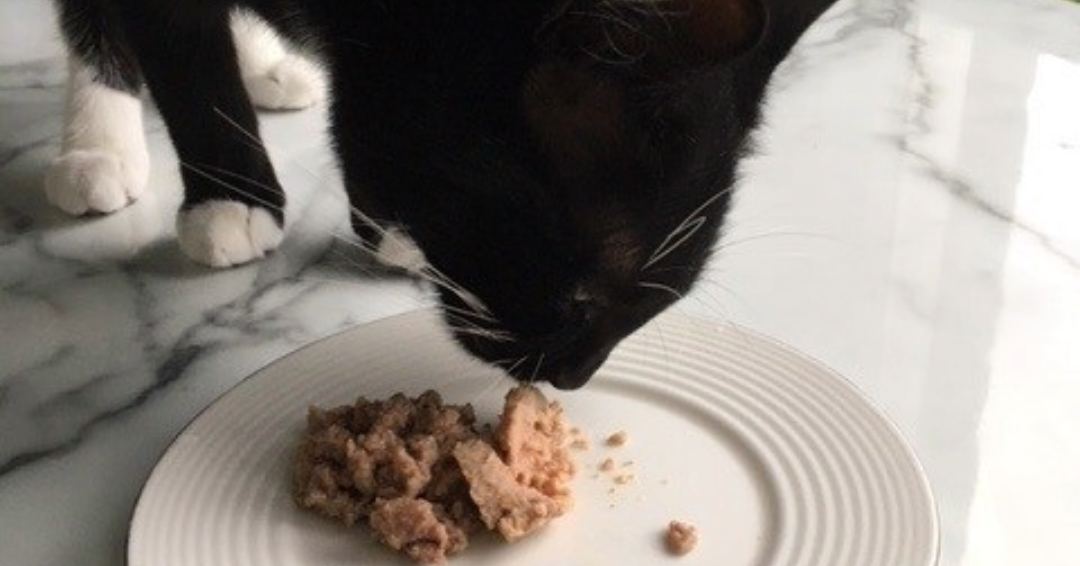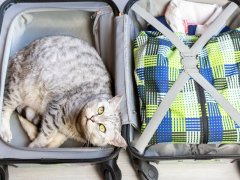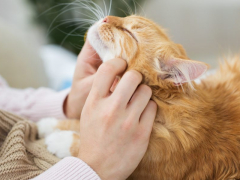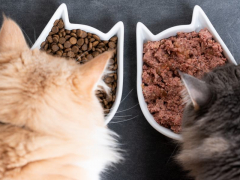
Melina Grin / Cats.com
Changing your cat’s food requires careful consideration and planning. Having lived with multiple cats at different life stages and with varying health conditions, I have had to alter my cats’ diets in the past, which involved many trials and adjustments.
Cats are naturally cautious creatures, so any deviation from their usual environment or diet can trigger suspicion and cause them to avoid novel food. New food smells and flavors trigger their survival instincts to avoid toxic substances in the wild.
No matter your specific reason for changing your cat’s food, you can follow some simple steps to ensure a smooth and safe transition for your feline companion.
Food for Life Stages and Conditions
Proper cat nutrition is important for your cat’s well-being and longevity. There are a number of reasons why changing your cat’s food might be beneficial or necessary.
A cat’s nutritional requirements change as they transition through life stages. A cat’s diet, therefore, needs to change based on their age and energy needs. Cat nutrition is different for kittens, adults, and seniors, as well as when cats are pregnant or lactating.
Certain medical conditions, such as urinary tract infection, diabetes, inflammatory bowel disease, hyperthyroidism, dental illness, or kidney failure or liver disease, may also call for a special diet. Your veterinarian will suggest a therapeutic or prescription diet for a specific duration or lifelong if the condition is chronic.
Treating Food Allergies or Intolerance
Like humans and dogs, cats can develop food allergies. Symptoms include itching, rashes, vomiting, and diarrhea. Common triggers are specific proteins (beef, chicken, eggs, pork, fish, and dairy products) or additives found in food.
According to two studies, [1] [2] food allergies can occur at any age and with any breed or mix, but Siamese cats and their crosses might be at a greater risk. Consult with your vet about changing your cat’s diet to an alternative protein, hypoallergenic diet, or balanced home-cooked diet for a two-month trial period to treat allergies or intolerances.
Supporting a Healthy Weight

Puzzle feeders provide mental stimulation and make mealtime more engaging for your cat. Melina Grin / Cats.com
Throughout your cat’s life, their weight may fluctuate between ideal, underweight, and overweight. Obesity is the most prevalent nutrition-related disorder in companion animals. Several studies identify obesity [3] as the second most common health issue in domestic cats, after dental disease. This issue is a significant reason why cat owners switch their cat’s food.
Also Read: Cat Obesity Chart: Find Out if Your Cat is Obese
To help your cat lose weight, opt for a diet high in lean protein, moderate in fat, and low in carbs. Foods higher in dietary fiber can also help cats feel fuller. You could also switch from free-feeding to measured meals, and it may help to change from dry kibble to a canned food with high moisture. Encourage exercise through play, such as with wand toys and puzzle feeders. If you’re unsure if your cat is the right weight, or how much you should be feeding them, speak to your veterinarian for advice.
Cats—especially seniors—are also known to be picky eaters. Any stressful event or illness can affect their desire to eat. You might need to tempt your cat to eat by serving canned food at room temperature or warming the food to increase its scent and appeal. Offering a variety of wet and dry food might also entice them back to the plate.
Adapting to Lifestyle Changes
Lifestyle changes, such as a shift in household members or personal finances, may have you looking into new types of food. When adopting a new kitten or adult cat, keeping them on the same diet for a few weeks is best to avoid tummy issues caused by the anxiety of changing homes.
But if the current diet isn’t suitable or if the cat becomes sick or refuses to eat, you might need to switch to a different type of food. We had to change our kitten’s food from dry to wet when Sienna got sick and lost her taste due to calicivirus. Luckily, she recovered fully.
In recent years, the cost of living has also been throwing pet parents for a loop. In the United States, only 3% of pet owners have pet insurance, and one in four pet owners worry about the high cost of vet care. Some cat owners face difficulties paying for adequate nutrition.
Also Read: How Much Is Pet Insurance for a Cat — Is It Really Worth It?
To alleviate financial pressures, you can switch your cat’s food to dry, make balanced homemade food, buy in bulk online, or opt for cheaper food options that meet their nutritional needs.
How to Change Your Cat’s Food
Changing your cat’s food abruptly can cause them problems, such as tummy upsets or food aversions. For the smoothest transition, follow these 10 simple steps:
1. Consult Your Veterinarian
Even though all kittens need to convert to adult food, and senior cats become ready to transition to a diet formulated for older cats, it’s best to talk to your veterinarian to assess your cat’s current nutritional requirements based on their history, weight, body, and muscle condition score.
2. Choose the New Cat Food
When switching food, choose a complete-and-balanced cat food with similar ingredients, texture, and analysis to ensure the same quality and benefits. If you’re altering to a new brand due to a health condition, it’s best to seek dietary advice from your vet.
3. Review the Pet Food Brand’s Website and Feeding Guide
For a smooth transition to your cat’s new diet, review the brand’s website and feeding guide, which will give specific tips for the transition and feeding amounts.
4. Plan the Change
It’s best to introduce new diets to your cat when they are healthy, since a sick cat might not accept a new food type and might develop a food aversion. Prepare and research thoroughly to ensure a smooth transition that meets your cat’s nutritional requirements over a steady period.
Veterinarian Dr. Joanna Woodnutt advises to avoid changing your cat’s diet when they’re involved in a very stressful situation, such as when they’re hospitalized.
“If forced to eat food when they feel anxious or nauseous, cats can develop an aversion which is very hard to overcome,” she said. “Even when a diet is needed for a medical reason, it’s usually best to change the food at home once the acute medical problem is over.”
5. Ensure a Gradual Transition
Transition your cat’s food gradually over 10 to 14 days. Begin by placing a small amount of the new food next to the old food on the same plate to introduce your cat to the novel scent and texture.
Progressively increase the amount of new food while decreasing the amount of the old food until your cat is solely eating the new diet. Don’t mix the foods, and do not worry if your cat doesn’t eat the new cuisine right away.
Here’s an example of how you can transition to a new type of food:
- Day 1 to 4: 75% old food + 25% new food
- Day 5 to 7: 50% old food + 50% new food
- Day 8 to 10: 25% old food + 75% new food
- Day 11 to 14: 100% new food
“Cats can be finicky about their food—they’ve evolved to be suspicious of new things, and so may turn down a new flavor or texture of food,” Dr. Woodnutt said. “This means it’s important to go slow when changing a cat’s diet. It doesn’t matter if it takes a few weeks!”
6. Reinforce Positive Associations With New Food

Place a small amount of the new food next to the old food to introduce your cat to the novel scent and texture. Melina Grin / Cats.com
Encourage your cat to eat the novel food by offering it during regular feeding times and removing any uneaten food after a reasonable amount of time.
Offer the new food in small quantities as a treat and praise your cat when they eat it to create a positive association with the latest nourishment. Feeding your cat within a calm environment can also help them feel more comfortable trying new food.
7. Observe Your Cat on the New Diet
Pay attention to your cat’s gastrointestinal health, especially concerning litter box habits. Regularly check your cat’s poop and be on the lookout for softness, unusual stool smell, constipation, or diarrhea. If you notice any blood or excessive mucus in the poop, it’s best to seek veterinary guidance.
Moreover, observe changes in your cat’s behavior, such as lethargy, lack of appetite, hiding, or sleeping.
8. Address Challenges During Transition
Monitor your cat’s reaction to the new food. If your cat throws up or has softer stools, stop feeding the novel diet and switch back to their usual brand for a few days before trying again. See a veterinarian if your cat experiences chronic diarrhea or symptoms of food allergies.
Cats might become sick or refuse to eat when they undergo a dietary change. If a cat goes as little as 24 hours without food, they can become severely ill and require veterinary care.
9. Be Patient
Give your cat ample time to adjust to a new diet, mainly if they have been eating the same thing as kibble for a long time.
Serafina, my female cat, tested my patience during the transition; it took her six months to switch from dry to canned food. That’s an extreme case, but it reminds us that some cats need more time than others to adjust to a new nutritional regime.
10. Complete the Food Changeover
Once your cat consumes 100% of the new food, complete the transition if no adverse reactions occur.
Frequently Asked Questions
Can I switch my cat’s food?
Yes, provided the new diet is complete, balanced, and suitable for your cat's life stage. Always talk to your vet before changing your cat’s food.
How long does it take for a cat to adjust to new food?
It typically takes 10 to 14 days for a cat to adjust to a new type of food, but remember that each cat has unique eating habits, taste preferences, and behavioral patterns. The key is to transition slowly and try different strategies for picky eaters. Instead of rushing the process, focus on changing to premium cat foods available.
What happens if you switch cat food too fast?
Changing your cat's food too fast can result in digestive problems such as vomiting or diarrhea, and your cat might refuse to eat the new food. It is important to gradually transition to the novel food to ensure your cat stays healthy and content.
Can changing my cat’s food give him diarrhea?
Cats might have a soft stool or diarrhea during food transition if this is done too fast, or the new diet is poorly tolerated. To avoid this, switch to a different food brand, slow the process, or stretch it over several weeks or months instead of 10 days.
-
Bryan, J. M., & Frank, L. A. (2010). Food allergy in the Cat: A diagnosis by elimination. Journal of Feline Medicine and Surgery, 12(11), 861–866.
-
Santoro, D., Pucheu‐Haston, C. M., Prost, C., Mueller, R. S., & Jackson, H. A. (2021). Clinical signs and diagnosis of feline atopic syndrome: detailed guidelines for a correct diagnosis. Veterinary Dermatology, 32(1), 26.
-
NCave, N., Allan, F., Schokkenbroek, S., Metekohy, C., & Pfeiffer, D. U. (2012). A cross-sectional study to compare changes in the prevalence and risk factors for feline obesity between 1993 and 2007 in New Zealand. Preventive Veterinary Medicine, 107(1–2), 121–133.
-
American Association of Feline Practitioners. (2004). Feline Behavior Guidelines.
-
Ackerman, N. (2016). Life stage nutrition in felines. I Cat Care.
-
National Research Council of the National Academies (2006). Your Cat's Nutritional Needs: A Science-Based Guide For Pet Owners.
-
Di Cerbo, A., Morales‐Medina, J. C., Palmieri, B., Pezzuto, F., Cocco, R., Flores, G., & Iannitti, T. (2017). Functional foods in pet nutrition: Focus on dogs and cats. Research in Veterinary Science, 112, 161–166.
-
I Cat Care (2020). Advanced Feline Behaviour for Vet Professionals, Module 2: Senses and Communication.







